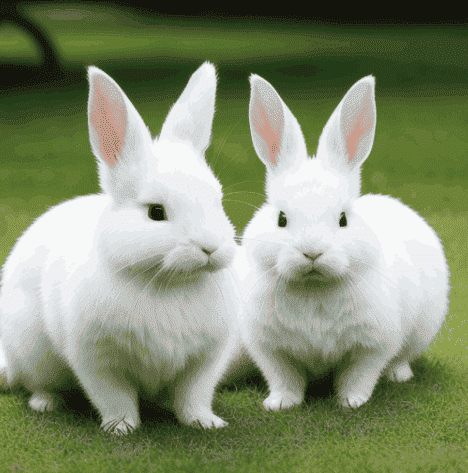Albino rabbits are indeed the hidden gems of the pet world. Their snow-white fur and bright red or pink eyes set them apart from others. But what makes them unique?
Albino rabbits are genetic wonders besides their attractive appearance. Albino genes hide all other colors, making these bunnies pure white.
They need a unique care approach due to their sensitive nature. So, if you are considering adopting one or already have one, you’re in the right place.
We’ll guide you through understanding and appreciating these unique pets, ensuring they thrive in your care.
Let’s dive right into it.
Table of Contents
Understanding Albino Rabbits
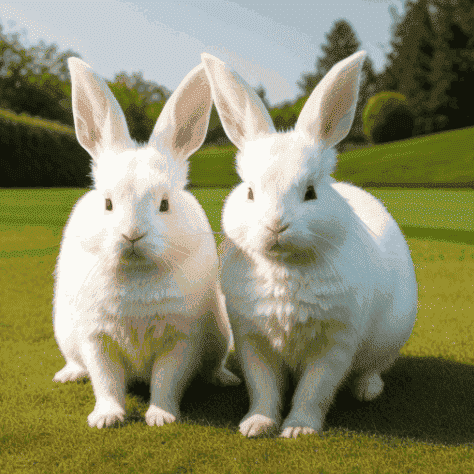
Albino rabbits are unique members of the rabbit family due to their lack of pigmentation. This is because of their genetic makeup, a topic worth exploring to understand them better.
What is Albinism in General?
In simple terms, albinism is a lack of pigmentation in genetic makeup. It’s an inherited trait from specific gene mutations interfering with melanin production. This pigment colors hair, skin, and eyes.
Key Characteristics of an Albino Rabbit
Beyond their unique white fur, albino rabbits show other distinct features. Albino rabbit eyes are another testament to albinism. Instead of brown or blue, albino rabbit eyes are pink or red. This color appears due to the blood vessels behind the iris, visible due to the lack of pigmentation.
Moreover, albino rabbits are known for their heightened sensitivity to sunlight, owing to their lack of protective melanin. So, they need special care to prevent sun exposure harm.
Albino vs. Non-Albino: Physical Differences
Albino and non-albino rabbits might be species of the same family, but they show distinct differences.
Non-albino rabbits can have many fur and eye colors, given the presence of melanin. They usually have brown, blue, or even grey eyes.
But, albino rabbits are recognizable by their white fur and pinkish-red eyes. The absence of other colors makes them an unusual and interesting variant in the rabbit world.
Why Albino Rabbits Are So Rare?
The rarity of albino rabbits lies within their unique genetics. Albino genes are recessive, meaning both parent rabbits must have these genes to produce an albino offspring. With this rare gene combination, albino rabbits become rare.
The popularity of Albino Rabbits
Despite their rarity, albino rabbits have garnered quite a fan base. Their snowy appearance and gentle behavior make them a favorite among rabbit lovers. They’re often spotted at rabbit shows, petting zoos, and in family homes, bringing joy with their unique charm.
Challenges in Breeding and Reproduction
Albino rabbit breeding has unusual challenges. Without genetic testing, it is difficult to identify rabbits carrying the recessive albino gene. Plus, because they have albinism, these rabbits are more sensitive to light and more likely to have health problems. This can complicate their breeding process.
But, with proper care and attention, these rabbits can lead healthy, fulfilling lives.
Pros and Cons of Albino Rabbits
When considering albino rabbits as pets, it’s essential to understand both the advantages and potential challenges that come along. Let’s explore some of the key aspects.
Pros of owning an albino rabbit
- Unique appearance
- Friendly nature
- Easy to spot
- Novelty characteristic
- Peaceful temperament
Cons of owning an albino rabbit
- Light sensitivity
- Indoor housing required
- Special diet needs
How to Choose an Albino Rabbit?
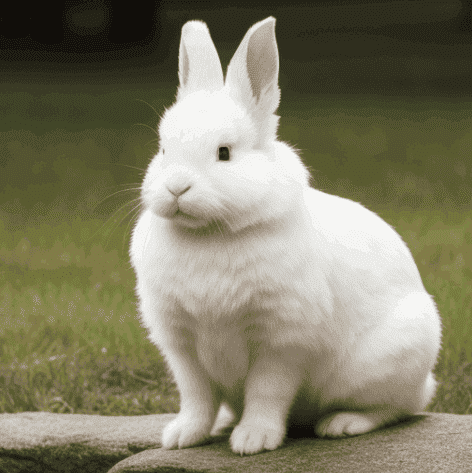
Selecting an albino rabbit should not be a hasty decision. These unique creatures need thoughtful consideration and adequate preparation before joining your family.
Factors to Consider When Buying or Adopting an Albino Rabbit
Here are the following factors to consider when you want to buy or adopt an albino rabbit:
- Albino rabbit health: Begin with a basic health check. Look for clear, bright eyes and clean ears. The coat should be soft and free from sores or bald patches. It’s good to see them active and alert.
- Cost implications: Owning an albino rabbit isn’t just about the buy or adoption fee. There are ongoing costs for food, grooming, healthcare, and toys. Ensure that you are financially ready for this commitment.
- Other pets in the home: Consider the impact of introducing an albino rabbit into a household with other pets. Will the other pets get along with the rabbit? Will the rabbit be safe?
- Space in your home: These rabbits need plenty of space to roam and play. Make sure you have enough room in your home for them to exercise.
- Rabbit’s temperament: Each rabbit has a unique personality. Spend some time with the rabbit to observe its behavior. Some are more social and playful, while others may be more reserved.
- Your schedule: Rabbits need daily care. They need your time for feeding, grooming, and playing.
- Support from a vet: It’s important to have access to a vet who understands rabbit health. This is particularly crucial for albino rabbits due to their unique health needs.
Considering these factors, you’ll ensure your albino rabbit gets a loving and suitable home.
Special Care for an Albino Rabbit
Albino rabbits, like all bunnies, need attentive care. But you must be aware of certain needs specific to these amazing creatures.
Housing Requirements for Albino Rabbits
An albino rabbit’s cage should be spacious, safe, and comfortable. Opt for indoor housing, as these rabbits are sunlight-sensitive due to their lack of pigmentation. A wire-bottom cage can harm their feet, so a solid bottom is crucial. Always keep the cage clean to prevent illnesses.
Exercise and Enrichment
Albino rabbits need both physical and mental stimulation. Create a secure play area where they can hop and explore. Toys, such as balls, tunnels, and chewable items, can provide mental stimulation. But, watch playtime as they are prone to chewing and can accidentally ingest harmful substances.
Grooming and Health Care
Regular grooming is important to keep your albino rabbit in top shape. Brush their fur weekly to remove loose hair and prevent digestive issues. Their teeth never stop growing, so provide chew toys to help wear them down.
Regular vet check-ups are also essential to check their health, especially albino rabbit eyes, as they are prone to certain issues due to albinism.
Common Albino Rabbit Breeds
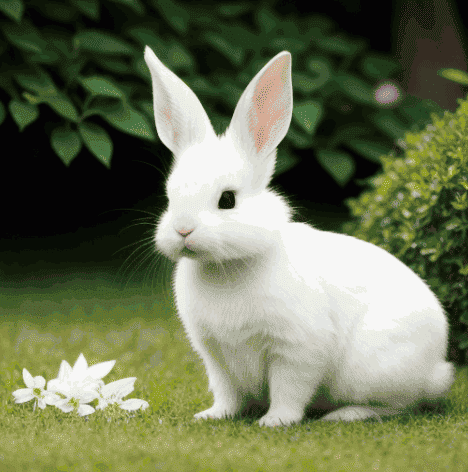
There are several popular breeds of albino rabbits. Each breed has special qualities that make it different from others.
Albino Lionhead Rabbit
The albino lionhead rabbit is well-liked for its playful demeanor. Albino lionhead rabbits are particularly charming due to their snowy-white fur. Albino lionhead rabbits are known for their intelligence and need mental stimulation, making them ideal for owners who love interactive play.
Albino Netherland Dwarf Rabbit
The Albino Netherland Dwarf is among the smallest rabbit breeds. They’re known for their round face with baby-like facial features. These cute bunnies are perfect for individuals who prefer smaller pets. They’re also well-suited for indoor living.
Albino New Zealand Rabbit
Albino New Zealand rabbits are larger and known for their friendly and calm nature. Due to their size, they’re often used as show animals or for meat and fur production.
Albino Mini Rex Rabbit
The Albino Mini Rex is known for its velvety fur and rounded body shape. They’re smaller in size and make a great pet for those looking for a low-maintenance rabbit.
Albino Flemish Giant Rabbit
The Albino Flemish Giant is one of the largest rabbit breeds. They’re known for their gentle nature and are often called the “gentle giant.” Albino Flemish Giant rabbits have larger ears. Their size requires more space and food than smaller breeds.
English Angora Albino Rabbit
The English Angora Albino Rabbit is known for its soft, long fur. These rabbits need regular grooming to prevent their fur from matting. They are social and friendly, making them perfect pets for those willing to do extra grooming.
Each of these albino rabbit breeds brings something different to your home. Your decision should hinge on your living conditions, time availability, and personal preferences.
Health Considerations for Albino Rabbits

Albino rabbits, like any other pet, require attentive care regarding their health. Their unique genetics show a set of potential health challenges that you should be aware of. Understanding these potential concerns is key to ensuring that your albino rabbit maintains a healthy and happy life.
Here are some of the health considerations to keep in mind when caring for an albino rabbit.
Sunburn
Sunburn isn’t just a problem for humans. Albino rabbits, with their lack of pigment, are susceptible too. Direct sunlight can harm their sensitive skin, causing discomfort or even serious burns.
Eye Problems
Those mesmerizing red eyes of albino rabbits are prone to issues. Photophobia, or light sensitivity, is common due to lacking pigmentation. This can lead to discomfort in bright environments.
Dental Issues
Like all rabbits, albinos are at risk for dental problems. Overgrown teeth can cause pain and interfere with eating. Regular checks by a vet will help spot any dental issues early.
Respiratory Issues
Respiratory troubles can be a concern, often signaled by a runny nose or frequent sneezing. Maintaining a clean living environment helps prevent such issues.
Genetic Disorders
While not specific to albinos, genetic disorders like malocclusion can occur. Regular veterinary checks are crucial for early detection and treatment.
Parasites and External Pests
Albino rabbits are as susceptible to parasites and pests as their colored counterparts. Regular grooming and cleanliness are key to preventing infestations.
Remember, being aware of these health considerations will help in providing the best care for your albino rabbit. Regular visits to the veterinarian are extremely important to make sure your albino rabbit stays happy and healthy throughout its life.
Breeding and Albino Rabbit Populations
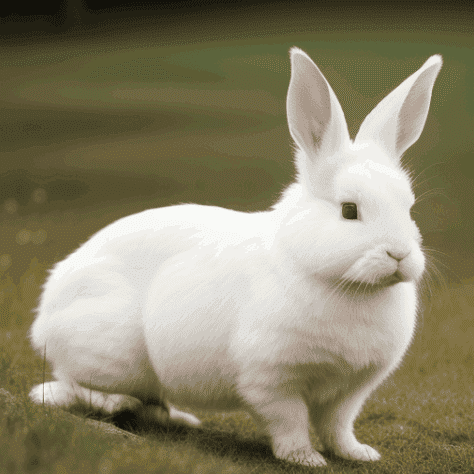
Albino rabbit populations are a topic of fascination and curiosity. Their unique genetics influence their breeding patterns and population distribution. It’s important to note that while albinism is relatively rare in the wild, it’s much more common in domesticated rabbits due to selective breeding.
Breeding albino rabbits requires a comprehensive understanding of their genetics. As we mentioned before, the albino traits are recessive. Both parent rabbits need to carry the gene to have albino offspring. But, choosing carefully is very important because if animals with similar genes mate too much, it can increase the chance of having health problems.
Albino rabbits are more typically seen as pets than in the wild. Therefore, their populations are lower. This is largely due to their lack of natural hiding, which makes predators more likely to attack them. This, combined with their sensitive health requirements, results in fewer albino rabbits in the wild than their colored mates.
Conclusion
Owning an albino rabbit gives a unique opportunity. Their stunning white fur and captivating red or pink eyes make them a truly amazing thing to see. Remember, these rabbits come with their own needs and health considerations, notably their sensitivity to sunlight and potential eye problems.
When you choose an albino rabbit, make sure to provide them with a suitable and safe environment. They need a space that protects them from sunburn and sharp objects that could harm albino rabbit eyes.
Your albino rabbit will reward your efforts with their lovely presence. You’ll have a charming pet with proper care and attention for years to come.
FAQs
Are albino rabbits friendly?
Albino rabbits are typically friendly, just like other rabbits. Their temperament is more determined by their breed and individual personality than their albinism. With proper socialization, they can become loving and sociable pets.
What do albino bunnies eat?
Albino bunnies have the same diet as any other rabbit. They eat a mix of hay, fresh vegetables, clean water, a limited amount of fruits, and a small number of pellets. Hay should make up about 70-80% of their diet as it’s essential for their digestive health.
How long do albino rabbits live?
The lifespan of an albino rabbit is comparable to other rabbits. They can live for about 8 to 10 years, with some even reaching 12 years. A balanced diet, regular exercise, good genetics, and attentive care contribute to a rabbit’s long life.
Can you breed albino lionhead rabbits with non-albino lionheads?
Yes, you can breed albino lionhead rabbits with non-albino lionheads. The offspring could inherit a combination of characteristics from both parents, including coloration. Proper breeding practices are crucial to ensure the health and well-being of the rabbits.
Alina Hartley is a small-town girl with a ginormous love of bearded dragons. It all started with Winchester, a baby bearded who was abandoned at the shelter by his former owners because of a birth defect that caused one front leg to be shorter than the other. Alina originally went to the shelter looking for a guinea pig, but one look at Winchester and it was love at first sight. From that day on, Alina has dedicated her life to learning everything she can about bearded dragons. She loves helping new beardie parents start their incredible journey with these magnificent reptiles.
Follow her on:
LINKEDIN
TWITTER.
Read her latest articles HERE
Learn more about her HERE.

